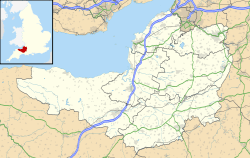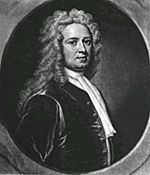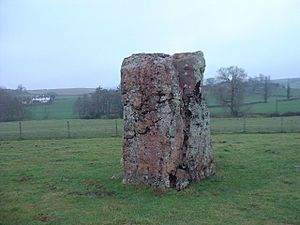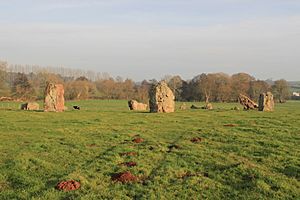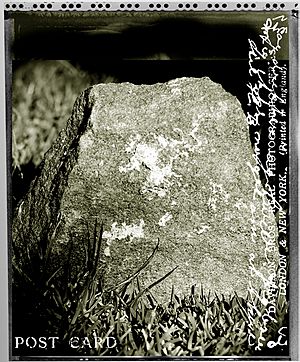Stanton Drew stone circles facts for kids
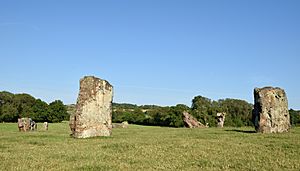 |
|
| Location | near Stanton Drew and Bristol |
|---|---|
| Region | Somerset, England |
| Coordinates | 51°22′02″N 2°34′34″W / 51.3671143°N 2.5760409°W |
| Type | Henge monument |
| Site notes | |
| Condition | intact |
The Stanton Drew stone circles are a group of ancient stones found near the village of Stanton Drew in Somerset, England. The biggest circle is called the Great Circle. It's about 113 metres (371 ft) wide and is the second largest stone circle in Britain, after Avebury. Many people believe it's one of the biggest monuments ever built during the Neolithic period, also known as the New Stone Age.
We don't know the exact date these circles were built. But experts think they were put up between 3000 and 2000 BCE. This means they were built in the late Neolithic period or early Bronze Age. The site was made a special protected place in 1982.
The Great Circle was once surrounded by a ditch. There are also two smaller stone circles nearby, one to the northeast and one to the southwest. You can also find three stones called The Cove in a local pub garden. A bit further away is a single stone known as Hautville's Quoit. Some stones still stand tall, but most have fallen over. A few stones are now missing from the site.
People have been studying these stone circles since 1664. Some digging was done in the 1700s. More recently, in the late 1900s and early 2000s, scientists used special equipment to look underground. These surveys confirmed how big the circles are. They also found more hidden pits and holes where posts once stood. The Cove stones are much older than the circles, dating back to 4000-3000 BCE. Many fun myths and legends have been told about the stones. One popular story is about dancers who were turned into stone!
Contents
What is the Stanton Drew Monument?
The most famous part of Stanton Drew is the Great Circle. It's the second largest stone circle in Britain. Only the one at Avebury is bigger. This huge circle is about 113 metres (371 ft) wide. It probably had 30 stones originally, but 27 are still there today.
Historians John Aubrey and William Stukeley both wrote about the Great Circle. It was likely surrounded by a ditch, which is now filled in. This ditch was about 135 metres (443 ft) across. The North East Circle is smaller, about 30 metres (98 ft) wide. It probably had 10 or more stones, with 8 still visible. The South West Circle is 43 metres (141 ft) wide and has 12 stones left.
There was also an ancient path, or avenue, leading from the Great Circle towards the River Chew. Another avenue connected to it from the North East Circle.
Hautville's Quoit Stone
Across the river to the north, you'll find a stone called Hautville's Quoit. It's a very large stone that has fallen over. People think it used to stand upright. It was described as being 13 feet (4.0 m) long in 1723. But now it's about half that size. Some people believe pieces were broken off to fix roads.
The Cove Stones
Further to the west, you can see a group of three stones called a cove. These are in the garden of the Druid's Arms pub. Two stones stand upright, with a flat stone lying between them. They are all different heights. The stones of The Cove are made of different rock types than the other stone circles.
Scientists have found an ancient burial chamber, called a long barrow, under The Cove stones. It's believed this burial place was built about a thousand years before the stones were put up.
How Were the Circles Explored?
In 1740, an architect named John Wood, the Elder studied and mapped the site. He noticed the different types of stones used. He thought the layout was based on the Pythagorean planetary system. He even believed it was a "University" for Druids.
When one of the stones fell in the mid-1600s, some human bones were found. A strange object, like a "large horse-bell," was also discovered. We don't know when the person was buried or what the bell-like object was for.
Modern Surveys
In 1997, a special geophysical survey was done by English Heritage. This survey looked underground without digging. It showed a ditch around the Great Circle. It also found nine rings of postholes inside the stone circle. These were more than four hundred pits, each about 1 metre (3 ft 3 in) wide. They were spaced out in rings. The ditch was 135 metres (443 ft) wide and about 7 metres (23 ft) deep. There was also a 40 metres (130 ft) wide entrance on the northeast side.
This survey changed how people saw Stanton Drew. It showed that the Great Circle is one of the largest and most amazing Neolithic monuments ever built. The pits likely held large wooden posts. These posts might have stood alone or had other posts connecting them at the top. They were too big to have supported a roof. The postholes were up to 1 metre (3.3 ft) wide. This means they held posts made from very old, large trees.
In 2009, another survey looked at The Cove stones. It showed that these stones are nearly a thousand years older than the stone circles. Scientists think these upright stones were probably the entrance or front of a burial tomb.
More surveys were done in 2010. They found a new entrance to the henge and even more details about the post holes.
Myths and Legends of Stanton Drew
Many people believe the stones at Stanton Drew were placed to line up with the stars. This is a common idea for stone circles and henge sites. There are also theories about ley lines, which are invisible lines connecting ancient sites.
Some people think the site was used for funerals. As a sacred place, it was probably also used for important community events. These might have included weddings or religious ceremonies.
There are several local stories about the stone circles. The most famous one tells how a wedding party was turned to stone. The party was happening on a Saturday. After midnight, a man dressed in black, who was actually the Devil, came and played his violin. He kept playing into Sunday morning. When the sun came up, everyone had been turned to stone by the Devil! The stone circles are said to be the dancers. The paths are the fiddlers. And The Cove is the bride and groom with a drunken churchman at their feet. The story says they are still waiting for the Devil to come back and play for them again.
Another old story says that a local wedding took place on a Sunday. The guests insisted on dancing, which was not allowed on a holy Sunday. As punishment, the whole wedding party was instantly turned into stone. This is why locals sometimes call the stones "The fiddlers and the maids."


